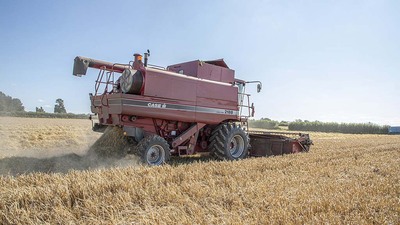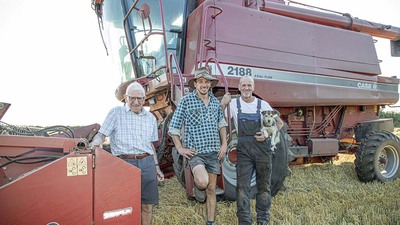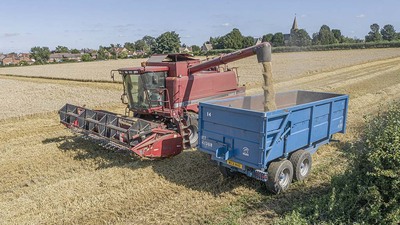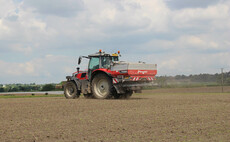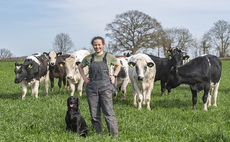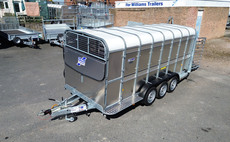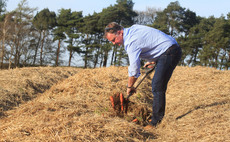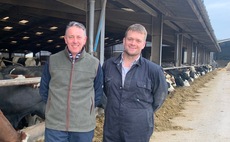
A 23-year-old Case IH 2188 Axial Flow provides cost-effective harvesting for one Wiltshire farm, as Geoff Ashcroft found out during a recent visit.
Without on-farm grain dying facilities, Ian Cradock and son Ashley rely on a combination of weather conditions and combine performance to bring in the harvest at their 140 hectare New Barn Farm, Hilperton, Wiltshire.
Ian says: "We really do rely on good weather.
"So when conditions are right, we cannot be scratching around, we have got to get on. If we had a decent summer, we can complete harvest in under two weeks, though it rarely goes so smoothly."
Until this year, the farm had relied on a New Holland TX62 with 5.1-metre header - it was a machine that had performed well during its seven-year tenure at New Barn Farm. But as Ashley was preparing the New Holland combine for the 2021 harvest, the 4,000-hour, 1997 TX was starting to show its age.
Ashley says: "The tyres had always been showing a few cracks, and it had always made me wonder if they would stay up, or whether they would fail in the middle of harvest.
"It reached a point where something had to be done, before we got caught out."
With the cost of replacement tyres potentially soaking up £4,000, and the prospect of spending more money on pre-harvest servicing, the decision was made to swap the combine.
"We decided to put the tyre cost towards the cost of changing the combine," says Ashley.
"And with a price put on our TX, I started to look around to see what we could get for our budget."
"Used combine choices are plentiful," he says.
"But the challenge was finding something that is not going to date too quickly. We still needed good parts availability, and a low-houred, well-maintained straightforward machine was important to us."
And with the top end of the combine market continuing to push the boundaries of output - and cost - with larger machines and wider headers, there is a useful supply of older combines with a modest capacity.
Ashely's time in Australia before coming back to the family farm had seen him working on 2188 and 7088 Axial Flow models. The Axial Flow was a machine he knew well, and influenced his search.
Trawling the internet led him to independent dealer PRC Agricultural, who was offering a 1998 model Axial Flow 2188 for well under £30,000. With 2,700 drum hours and 3,200 engine hours, plus 6.1m 1030 header and trolley, this well-looked after example was rumoured to have come from a well-known Cotswold Farm, where it would have handled a 404ha workload.
Case IH's Axial Flow combine has been through many subtle changes since it was launched in 1977. Many have been horsepower led, but the single rotor combine design has changed little from that early introduction.
It uses a large longitudinal rotor to provide a generous threshing and separation area in a short wheelbase harvester. While the Axial Flow is capable of producing a good sample, its critics soon highlighted the lack of a decent swath of straw for baling. But more recent versions - along with the knowledge of correct settings - can give impressive results.
Powered by a Cummins 8.3-litre turbocharged diesel engine, the 2188 offers 280hp and hydrostatic drive.
Ashley says: "With more power, more performance and a wider header, the 2188 was exactly what I would hope we would find.
"It is a machine that once handled 1,000 acres per year, so it should have no problem with our acreage."
"And the cost to change was less than the cost of two replacement drive tyres," he adds.
He says the combine offers auto-levelling for the header, and an auto lift/lower returning to the same pre-set cutting height.
Ashley adds: "Mechanical simplicity and cable control is the key for us.
"And this is where the 2188 fits right in. We can then continue to service and repair our own kit, without relying on specialists."
The arrival of the 2188 on-farm in July has given the Cradocks a useful boost in capacity, for very little outlay, representing a cost-effective upgrade. Though the extra capacity also provides scope for taking on more work.
"We have been cutting at forward speeds of around 6.5kph, and taking an extra metre with every pass," says Ashley.
"That is nearly twice the forward speed of our old TX, as you can load up the Axial Flow drum and push on."
"In oilseed rape, we cut our entire 60 acres of crop in just 10 hours. The TX would have cut just 40 acres in the same time frame," he adds.
"So if Mother Nature plays ball, harvest could be done in a week."
"The Axial Flow cab is also a comfortable place to sit, with a great view from the large, curved windscreen," adds Ashley.
The Cradocks grow OSR, spring barley and beans, with turnips, grass and fodder crops in the rotation to supplement over-wintered grazing for shepherds. While straw quality is likely to be different from the switch to a higher capacity rotary combine from a straw-walker model, a neighbouring dairy farm bales and moves the straw in return for a supply of manure.
Ashley says: "When cereal crops get down to 15 per cent, we are off.
"All our land is within two miles of the farm, though access can be challenging through villages. The combine is big enough."
Field sizes extend from 1.2 to 60ha, with the smallest field causing the biggest challenge.
"There are three poles and a pylon to negotiate," says Ashley.
With more capacity comes a faster flow of grain, and to ensure logistics continue without impact, the farm operates with four trailers, comprising 12, 14 and 16 tonne capacities. Unloading can be on the move, or into strategically placed trailers on the headland.
Ian says: "Spare trailers provide useful holding capacity.
"The bottleneck is most likely to occur back at the yard, where a series of grain bins and low-height traditional buildings pose different challenges."
"This year, we bought an auger-elevator so we can make better use of space in the sheds, and heap the grain a little deeper," he adds.
"Tipping larger trailers in low buildings is nigh-on impossible. So we are far better off using an auger."
Ian says that having extra trailers also affords an element of buffer storage, allowing the combine to keep going into the night.
He adds: "We can empty trailers and move grain each morning, before we go combining, freeing up capacity ahead of a day's harvesting. It is a good system, which now benefits from a little extra combine capacity."
